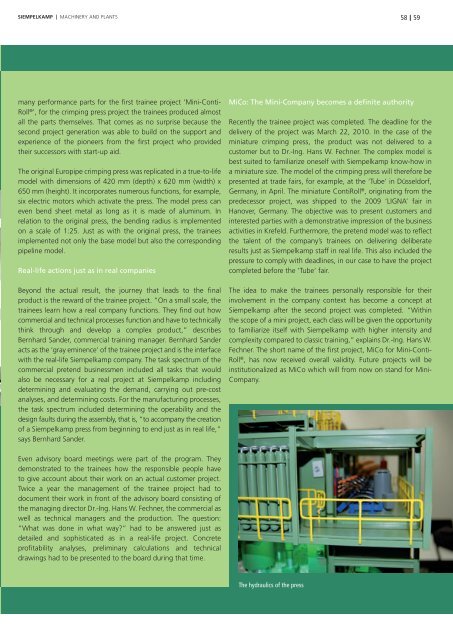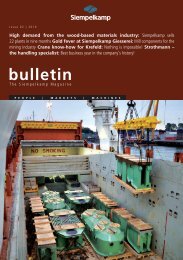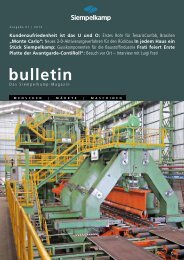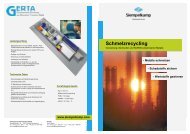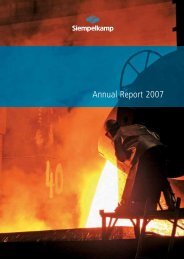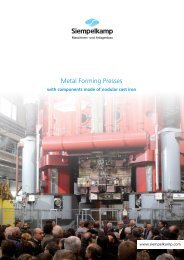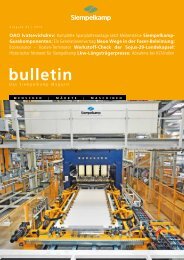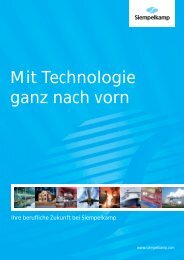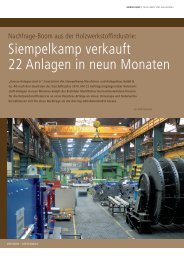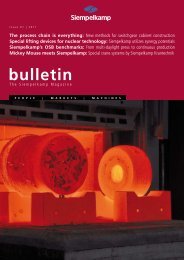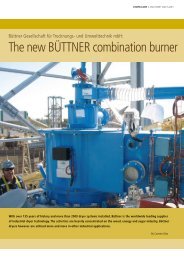Bulletin 1/2010 - Siempelkamp NIS
Bulletin 1/2010 - Siempelkamp NIS
Bulletin 1/2010 - Siempelkamp NIS
You also want an ePaper? Increase the reach of your titles
YUMPU automatically turns print PDFs into web optimized ePapers that Google loves.
SIEMPELKAMP | MACHINERY AND PLANTS<br />
many performance parts for the fi rst trainee project ‘Mini-Conti-<br />
Roll ® ’, for the crimping press project the trainees produced almost<br />
all the parts themselves. That comes as no surprise because the<br />
second project generation was able to build on the support and<br />
experience of the pioneers from the fi rst project who provided<br />
their successors with start-up aid.<br />
The original Europipe crimping press was replicated in a true-to-life<br />
model with dimensions of 420 mm (depth) x 620 mm (width) x<br />
650 mm (height). It incorporates numerous functions, for example,<br />
six electric motors which activate the press. The model press can<br />
even bend sheet metal as long as it is made of aluminum. In<br />
relation to the original press, the bending radius is implemented<br />
on a scale of 1:25. Just as with the original press, the trainees<br />
implemented not only the base model but also the corresponding<br />
pipeline model.<br />
Real-life actions just as in real companies<br />
Beyond the actual result, the journey that leads to the fi nal<br />
product is the reward of the trainee project. “On a small scale, the<br />
trainees learn how a real company functions. They fi nd out how<br />
commercial and technical processes function and have to technically<br />
think through and develop a complex product,” describes<br />
Bernhard Sander, commercial training manager. Bernhard Sander<br />
acts as the ‘gray eminence’ of the trainee project and is the interface<br />
with the real-life <strong>Siempelkamp</strong> company. The task spectrum of the<br />
commercial pretend businessmen included all tasks that would<br />
also be necessary for a real project at <strong>Siempelkamp</strong> including<br />
determining and evaluating the demand, carrying out pre-cost<br />
analyses, and determining costs. For the manufacturing processes,<br />
the task spectrum included determining the operability and the<br />
design faults during the assembly, that is, “to accompany the creation<br />
of a <strong>Siempelkamp</strong> press from beginning to end just as in real life,”<br />
says Bernhard Sander.<br />
Even advisory board meetings were part of the program. They<br />
demonstrated to the trainees how the responsible people have<br />
to give account about their work on an actual customer project.<br />
Twice a year the management of the trainee project had to<br />
document their work in front of the advisory board consisting of<br />
the managing director Dr.-Ing. Hans W. Fechner, the commercial as<br />
well as technical managers and the production. The question:<br />
“What was done in what way?” had to be answered just as<br />
detailed and sophisticated as in a real-life project. Concrete<br />
profi tability analyses, preliminary calculations and technical<br />
drawings had to be presented to the board during that time.<br />
MiCo: The Mini-Company becomes a defi nite authority<br />
Recently the trainee project was completed. The deadline for the<br />
delivery of the project was March 22, <strong>2010</strong>. In the case of the<br />
miniature crimping press, the product was not delivered to a<br />
customer but to Dr.-Ing. Hans W. Fechner. The complex model is<br />
best suited to familiarize oneself with <strong>Siempelkamp</strong> know-how in<br />
a miniature size. The model of the crimping press will therefore be<br />
presented at trade fairs, for example, at the ‘Tube’ in Düsseldorf,<br />
Germany, in April. The miniature ContiRoll ® , originating from the<br />
predecessor project, was shipped to the 2009 ‘LIGNA’ fair in<br />
Hanover, Germany. The objective was to present customers and<br />
interested parties with a demonstrative impression of the business<br />
activities in Krefeld. Furthermore, the pretend model was to refl ect<br />
the talent of the company’s trainees on delivering deliberate<br />
results just as <strong>Siempelkamp</strong> staff in real life. This also included the<br />
pressure to comply with deadlines, in our case to have the project<br />
completed before the ‘Tube’ fair.<br />
The idea to make the trainees personally responsible for their<br />
involvement in the company context has become a concept at<br />
<strong>Siempelkamp</strong> after the second project was completed. “Within<br />
the scope of a mini project, each class will be given the opportunity<br />
to familiarize itself with <strong>Siempelkamp</strong> with higher intensity and<br />
complexity compared to classic training,” explains Dr.-Ing. Hans W.<br />
Fechner. The short name of the fi rst project, MiCo for Mini-Conti-<br />
Roll ® , has now received overall validity. Future projects will be<br />
institutionalized as MiCo which will from now on stand for Mini-<br />
Company. ow on stand for Mini-Company.<br />
The hydraulics of the press<br />
58<br />
59


